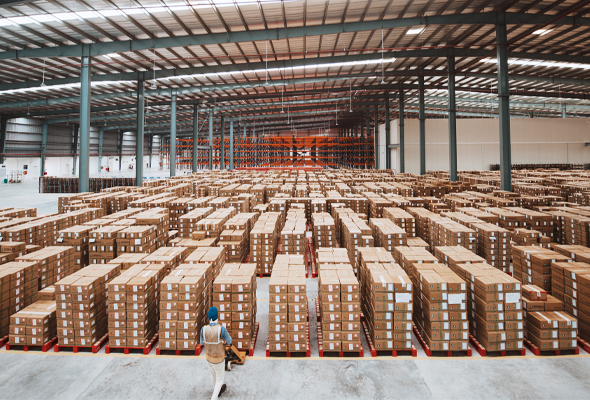Dilapidated, old buildings known as godowns used just for storage and nothing else have evolved immensely over the past few years. These worn-down buildings are now automated, sophisticated warehouses which serve more than one purpose. Following are the trends observed in warehouse design in India over the years, which have led to the creation of strong and flexible supply chains -

Warehouses are no longer used only for storing goods. They are also used for inventory management, pick-up, package, and shipment facilities. Many warehouses also provide transport logistics services. These factors have led to an increase in the size and space of warehouses. The average size of warehouses in India has grown significantly from 1-1.5 lakh sq. ft. to 3-5 lakh sq ft. In non-metropolitan cities, the size can vary between 50,000 sq. ft. and 75,000 sq. ft.[2]
For example, With over 10 lakh sq. ft. warehouse space, Varuna Group has 25+ Grade A warehouses pan India for its customers.
With India participating in the wave of digitalisation along with other nations, we are witnessing an increased introduction and integration of technology in all spheres of business. The march toward automation continues under the promise of greater cost savings and efficiencies. Today’s warehouses leverage technology such as IoT, robotics, AI, machine learning and automation to enhance their operations. A few ways warehouses increase their capabilities are enhanced real-time tracking, self-driven vehicles, and AI-powered inspection and warehouse management systems.
Varuna Group capitalises on technology using its dedicated and robust Warehouse Management System (WMS) and Transport Management System (TMS) to ensure greater operational efficiency.
While the size of warehouses has increased significantly, so has their carbon footprint. Many companies are now being mindful of the impact of their actions and taking conscious measures and efforts to reduce and limit the carbon footprint of their warehouses. From switching to greener suppliers, vehicles, and lighting to adopting green practices in the workplace, companies are becoming more aware and sensitive to the needs of their planet.
Companies like Varuna Group, for example, relies on renewable energy such as solar energy.
Warehouses have evolved to become more safe and secure. This protects not only the staff but also the goods. Most companies take necessary precautions to prevent hazards at the workplace such as fires, electrical failure, etc. With the onset of the pandemic, companies are also providing their employees with a safe working environment by providing them with PPE and safety equipment to minimise the risk of infection.
Varuna Group ensures the safety of its employees and warehouses by providing its employees with adequate and appropriate safety equipment along with training on multiple safety hazards and the correct action to be taken during an emergency. The company also has provisions for preventing electrical and fire hazards, such as installing portable fire extinguishers placed at every 1000 sq. ft. The company is also one of the first in India to have introduced wireless scanners in their warehouses to avoid counterfeiting, along with a weighment system to avoid pilferage. In this way, Varuna Group ensures the completion of each quality check as per the defined SOPs so that it is easier to spot non-compliance issues and speed up their resolution.

As businesses become flexible and agile, so have warehouses. Flexibility in the face of fluctuating demand has been a hallmark of modern warehousing in recent years. Flexi-warehousing is changing the face of warehousing in India by providing customers with customised solutions based on their varying needs, demands and requirements.
For instance, Varuna Group’s flagship MUF at Shambhu Naka near Ambala in Punjab is a single block of 4.2 lakh sq. ft. It has a 60 feet approach road that offers a Grade A warehouse experience with world-class infrastructure to all its customers.
Warehouses today have expanded their capabilities by making provisions for warehouse services like refrigerated or cold storage. Changes in warehouse design range from the type of dock (cold dock or ambient dock) installed, design of vapour barrier, type of refrigerant (for example, hydrofluorocarbons (HFCs), CO2, ammonia, etc.), etc.
Warehouse companies in India are now bracing themselves for the future. They are set to transform warehouses in India with the latest trends and technology, such as introducing drones, robots, 3D printing, and augmented reality. The integration of such technology may lead to on-demand smart warehouses, closely integrated with manufacturing. This may enable companies to operate out of flexible warehouses with adaptive designs which may contract or expand on-demand, helping them save costs and increase productivity and efficiency. Moreover, given the demands of various industries, many warehouse companies in India are now also providing last-mile delivery solutions to their customers. These services are, thus, expanding the scope for modern-day warehousing.
Contact us today for detailed insights on how Varuna Group can support your business.
Trends include automation, multi-storey warehouses, green building practices, IoT-enabled tracking, flexible layouts, and integrated safety systems.
Automation reduces manual errors, improves speed, and increases storage efficiency, leading to cost savings and better productivity.
By using solar panels, energy-efficient lighting, water recycling, and eco-friendly construction materials.
Advanced tech like AI, IoT, and WMS (Warehouse Management Systems) improves inventory tracking, space utilization, and operational efficiency.
Drive efficiencies throughout your supply chain with our technology-enabled services